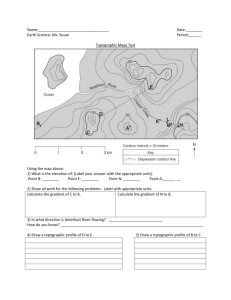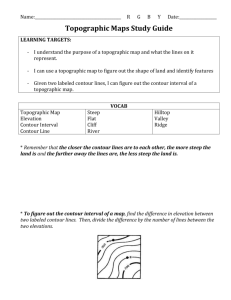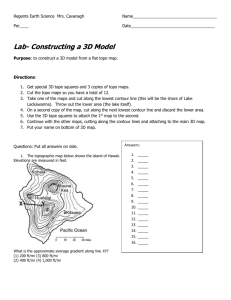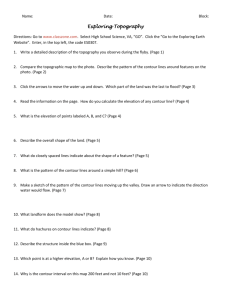Middle School STEM Science Lab/Activity Planner
advertisement
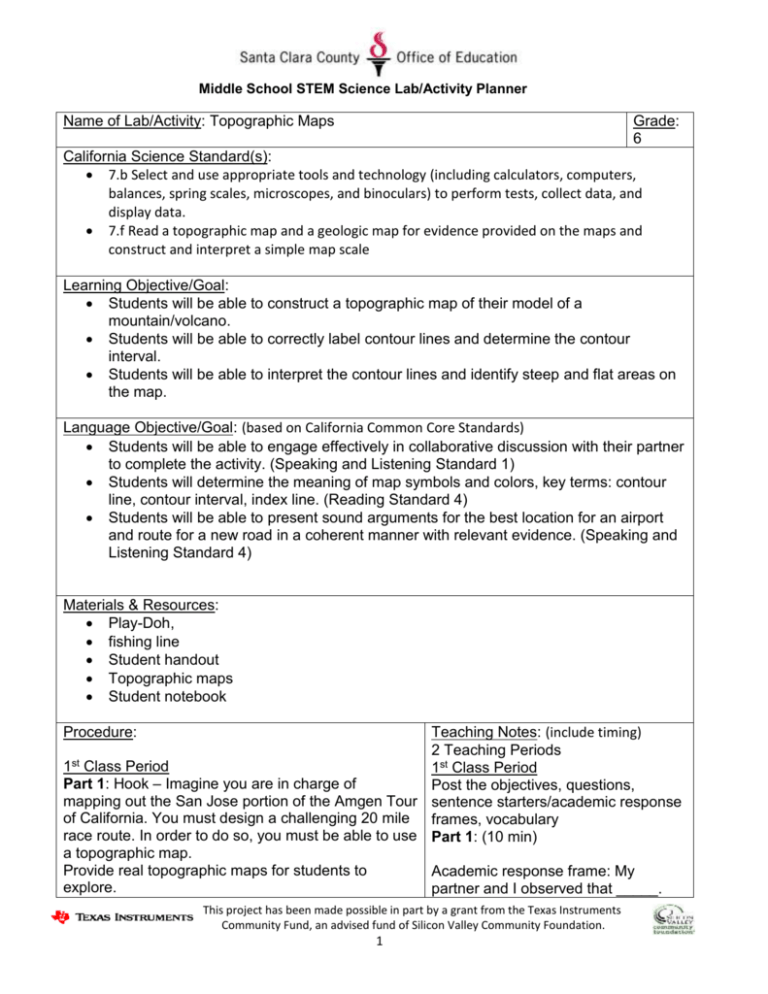
Middle School STEM Science Lab/Activity Planner Name of Lab/Activity: Topographic Maps Grade: 6 California Science Standard(s): 7.b Select and use appropriate tools and technology (including calculators, computers, balances, spring scales, microscopes, and binoculars) to perform tests, collect data, and display data. 7.f Read a topographic map and a geologic map for evidence provided on the maps and construct and interpret a simple map scale Learning Objective/Goal: Students will be able to construct a topographic map of their model of a mountain/volcano. Students will be able to correctly label contour lines and determine the contour interval. Students will be able to interpret the contour lines and identify steep and flat areas on the map. Language Objective/Goal: (based on California Common Core Standards) Students will be able to engage effectively in collaborative discussion with their partner to complete the activity. (Speaking and Listening Standard 1) Students will determine the meaning of map symbols and colors, key terms: contour line, contour interval, index line. (Reading Standard 4) Students will be able to present sound arguments for the best location for an airport and route for a new road in a coherent manner with relevant evidence. (Speaking and Listening Standard 4) Materials & Resources: Play-Doh, fishing line Student handout Topographic maps Student notebook Teaching Notes: (include timing) 2 Teaching Periods 1st Class Period 1st Class Period Part 1: Hook – Imagine you are in charge of Post the objectives, questions, mapping out the San Jose portion of the Amgen Tour sentence starters/academic response of California. You must design a challenging 20 mile frames, vocabulary race route. In order to do so, you must be able to use Part 1: (10 min) a topographic map. Provide real topographic maps for students to Academic response frame: My explore. partner and I observed that _____. Procedure: This project has been made possible in part by a grant from the Texas Instruments Community Fund, an advised fund of Silicon Valley Community Foundation. 1 Must know vocabulary: topographic map, elevation, sea level, contour line, contour interval Part 2: Direct instruction – Distribute the student worksheet. Teacher provides direct instruction of the activity, and models the procedure to make the map. Part 2: (10 min) Use document camera to demonstrate. Part 3: (25 min) Part 3: Students get materials. Working in pairs, they construct a play-Doh mountain and make the topographic map. 2nd Class Period 2nd Class Period Pick up where you left off. Discuss what the contour lines represent. Point to different locations on the same contour line, and ask students to tell you the elevation. On a topographic map, pairs will determine the best location for an airport, new road, and race route. Pairs will present their argument to class. Math Connection: Students can determine change in elevation Students can create a map scale and compute various distances on their map Teaching Notes:: Technology Extension of Learning: Web-based activity using individual computers/laptops with internet access Teaching Notes: Check ahead of time that the laptops are available and working. Link: http://www.nationalgeographic.com/xpeditions/lessons/01/g68/dogsta ils.html http://erg.usgs.gov/isb/pubs/teacherspackets/mapshow/activity4.html http://www.windows.ucar.edu/tour/link=/teacher_resources/teach_tat erland.htm Formative Assessment: (please attach a copy) Show a topographic map, and ask: 1. Where is the landscape the steepest? (A, B, C, or D) 2. What is the change in elevation from point A to point B? 3. What is the contour interval? Strategies for EL and Special Needs Students: Teaching Notes Project images. Use white boards or class response system Vocabulary: This project has been made possible in part by a grant from the Texas Instruments Community Fund, an advised fund of Silicon Valley Community Foundation. 2 Posted discussion questions and academic response Topography, elevation, sea level, frames, sentence starters, modeling, Graphic contour line, contour interval organizers, homework – labeling, use of images. Alignment in science unit: (Brief description of lessons taught prior to & after this lab/activity) Unit: Mapping Earth’s Surface The lessons prior to teaching Topographic Maps: Lesson/Discussion/Activity on types of maps and their uses, features common to most maps: map key/legend, compass rose, map scale, map view, profile view, using latitude and longitude coordinates to pinpoint location After teaching about topographic maps, the next lesson would be on geologic maps: rock formations, depositional and fault contacts, real world uses. Brief description of lessons taught after this lab/activity: After learning about topographic maps, students will learn about the uses of geologic maps. Much later in the year, students are introduced to bathymetric maps, so there is opportunity to review and access prior knowledge of maps. Lab/Activity adapted from: (website, textbook, etc.) http://www.nationalgeographic.com/xpeditions/lessons/01/g68/dogstails.html http://erg.usgs.gov/isb/pubs/teachers-packets/mapshow/activity4.html http://www.windows.ucar.edu/tour/link=/teacher_resources/teach_taterland.htm This lesson was developed by: Teacher’s Name Formative Assessment adapted from: Currently Teaching at: (School & District) Hoover Middle School, San Jose Unified School District George Middle School, Alum Rock Unified School District Subha Banerjee Karen Lombardo This project has been made possible in part by a grant from the Texas Instruments Community Fund, an advised fund of Silicon Valley Community Foundation. 3


